2016 Annual Report
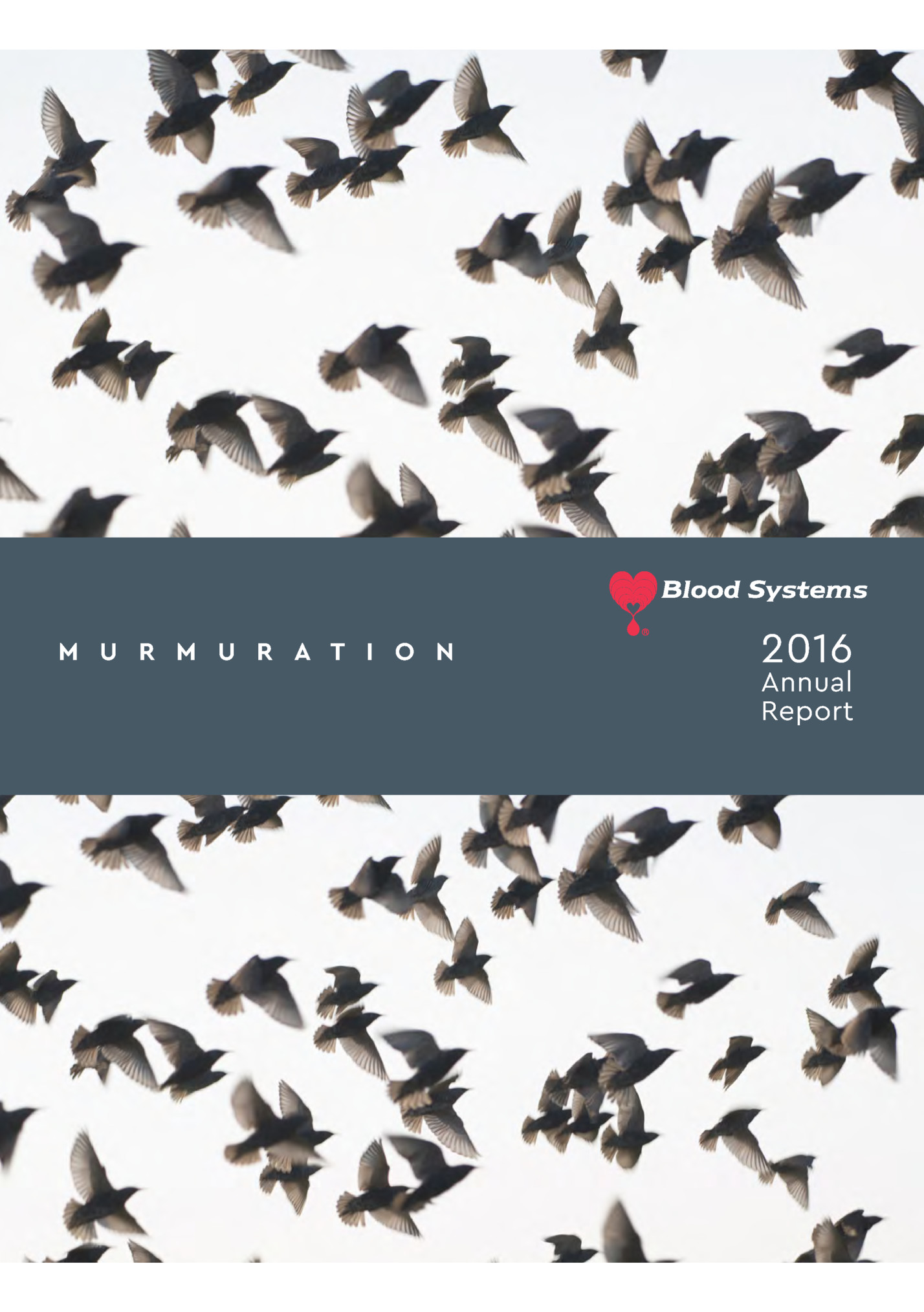
In one of the most astounding natural phenomena, the murmuration of starling birds makes it appear as if each individual bird is physically connected. These birds effortlessly and dramatically change direction and perform complicated movements in flight. As the largest and most complex organization we’ve ever been, Blood Systems looks to take a lesson from these birds and their ability to move as one. We work toward a synchronized, nimble and united company driven by a strong cause. The stunning movements of starlings are intentionally executed together. So shall ours be. To see a starling murmuration in motion, visit https:/ /tinyurl.com/jsjhfst

CHAIRMAN & CEO THE YEAR 2016 was indeed a time of threat of Zika virus prompted swift ac- Blood Systems adopted Operation- transformation, transition and growth tion from our labs to initiate testing. al Excellence as our methodology for for Blood Systems®. Not unlike the Creative Testing Solutions® in Tampa creating a sustainable culture of day- murmuration of starlings, we navigat- was the first in the country to imple- to-day learning and leading practic- ed ever-changing times in as synchro- ment Zika testing with Blood Systems es. Based on the acclaimed Shingo nized a way as possible. It was not Research Institute® and FDA support. Model™, Operational Excellence em- without challenge. External forces like We began ferritin testing on blood powers all employees to be problem the possible effects of blood donation donations from all 16- to 18-year-old solvers to improve work efficiency in on young donors and the continuing donors. This was in light of studies small and big ways. Training launched indicating that teen repeat blood do- with management-level staff in De- nors may be more likely to become cember, the beginning of a three-year iron-deficient than older donors. Clin- assimilation program. “ We continue to build a sustainable, diverse organization— one conducive to anticipating change together...” ical evidence suggests that teens with Both Blood Systems Research In- low ferritin should wait six months to a stitute and BioCARE® expanded their year before donating again to rebuild reach in 2016. BSRI opened a second lo- iron stores. Donor and patient safety cation in Denver and, in order to expand will always be our top priority; at the into new business arenas, BioCARE same time, these initiatives absolute- became a wholly-owned, for-profit ly affect blood availability. Driving the subsidiary beginning January 1, 2017. cultivation of new donors, especially As BioCARE President Linda Matthews those aged 25-45, to rebuild collec- said, “This new status allows BioCARE tions is the primary focus of our new and CanyonCARE Rx® to offer a broad- Donor Marketing team. er product portfolio, becoming more Internally, we dramatically reorga- competitive in the acute and non-acute nized our Blood Centers Division to, as markets, which will assist in the contin- Blood Services President Dave Green ued growth of our organizations.” said, “…make the most of the strengths For 2016, the true constant for of our system: to leverage tremen- Blood Systems was change. In light dous talent and experience, to create of the fact that it looks to carry on a shared infrastructure, to eliminate this way, we continue to build a unnecessary duplication, to drive out sustainable, diverse organization— costs.” This structure better supports one conducive to anticipating this standardization efforts and properly change together (like the murmur- brings together new business units ation of starlings). and employees, like the 1,400 from Bonfils Blood Center®, Blood Centers of the Pacific®, BloodSource®, Inland Blood Systems President and CEO Northwest Blood Center®, Lifeblood® Dan Connor enjoys a virtual test drive and LifeShare® we welcomed in 2016. on the Harley-Davidson that was At November’s Launch event, leaders raffled for use in a blood donation from across the organization gathered giveaway. The blood centers of the to celebrate, get acquainted and, well, Mountain Division won the raffle. launch the next era of Blood Services. John S. Lewis, Chairman J. Daniel Connor, President & CEO 3
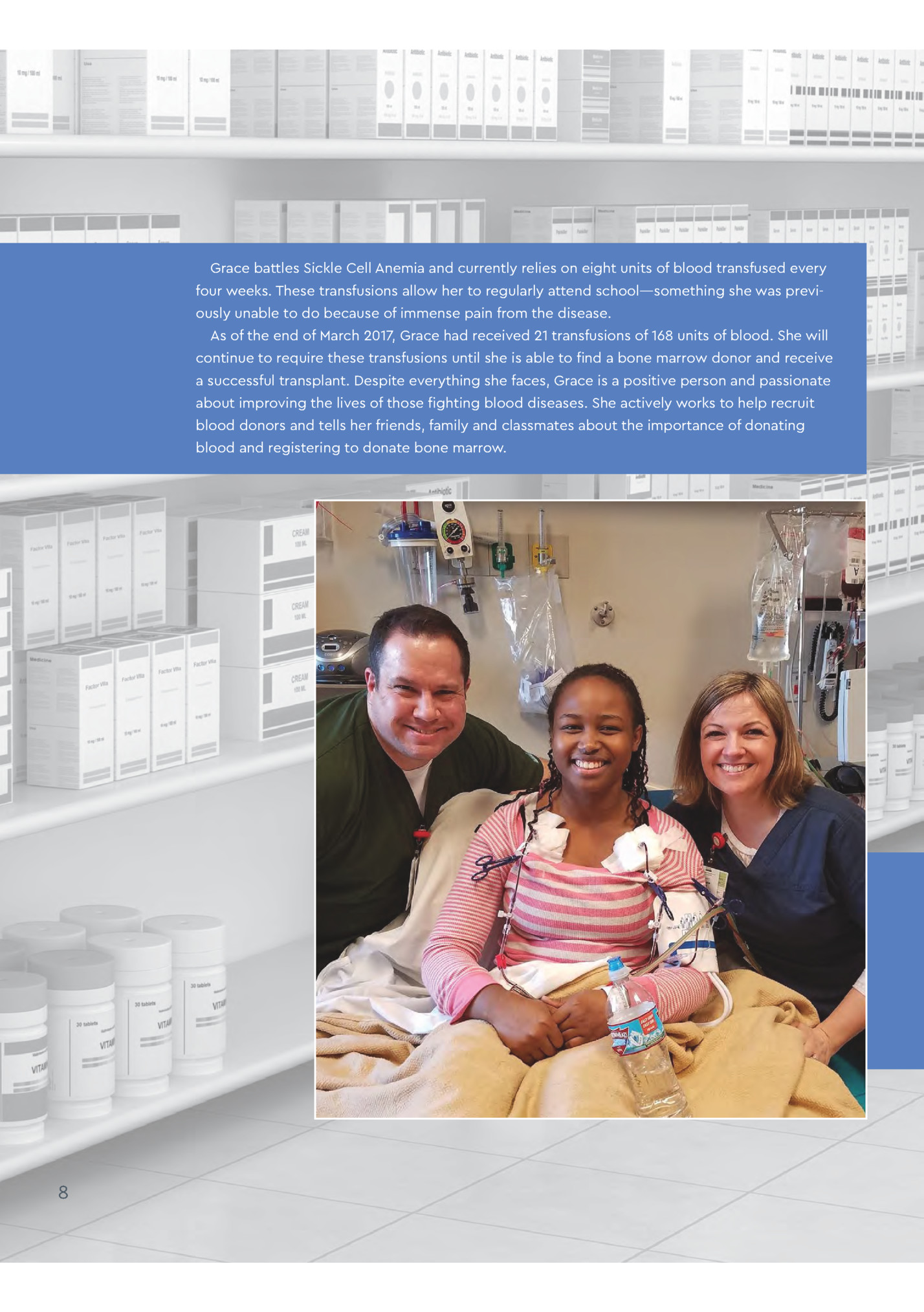
(HLH), a life-threatening, rare blood disease, when he was seven months old. Blood transfusions sustained him until a compatible marrow donor was found. Tony received his marrow transplant at age two, enduring harsh chemotherapy and countless transfusions of platelets, plasma and red blood cells. Tony is now 11 and his family is incredibly active. Tony often leads the charge. He likes sports, has a mouthful of braces and loves to be silly. “Tony is healthy and living a very normal life what could be — better?” says his mother, Kasey. “There’s not a day that goes by when we don’t give thanks for those who donate blood.” 4
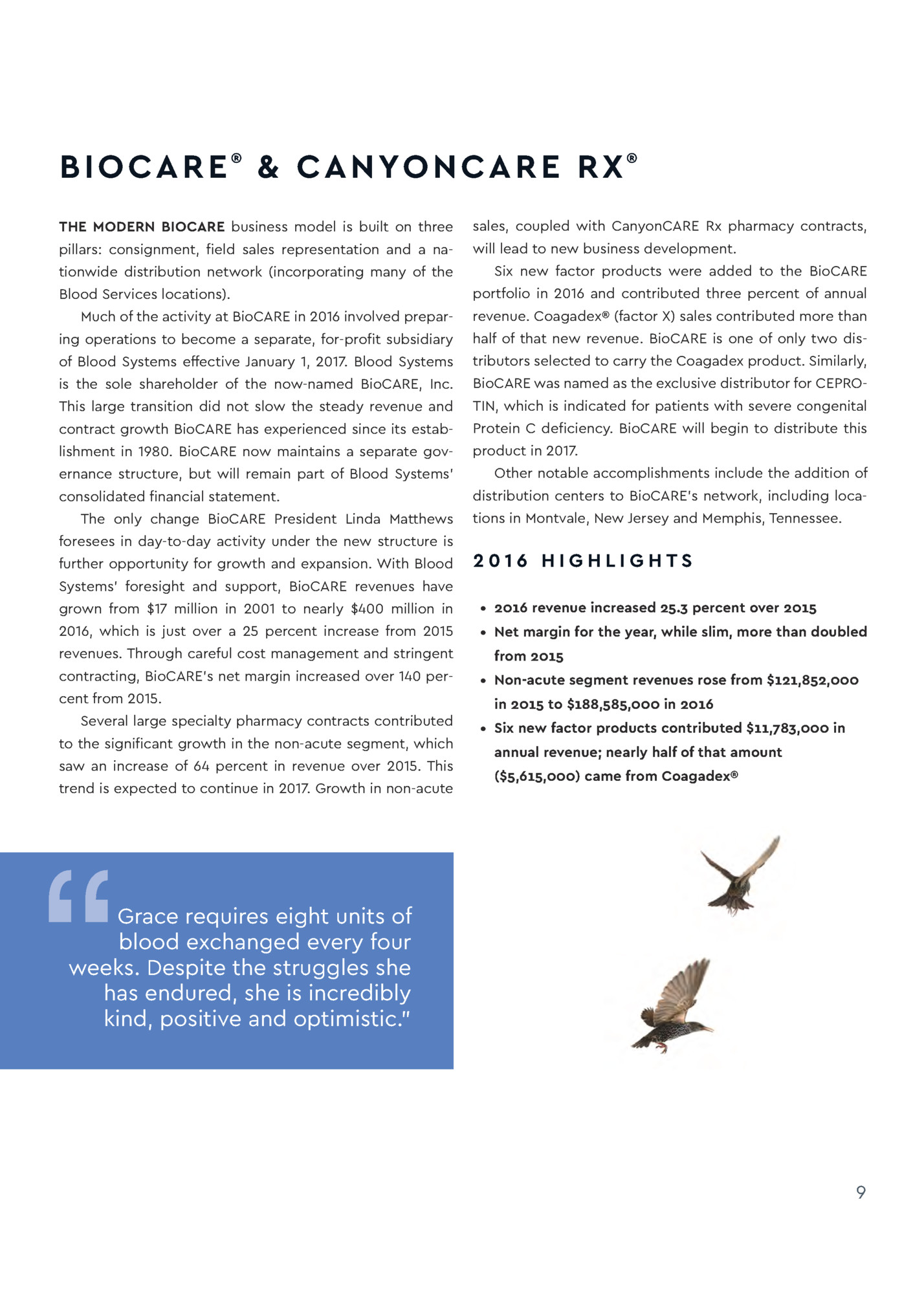
THE BLOOD CENTERS Division (renamed Blood Services Additionally, a Corporate Authorities council now serves to at midyear) significantly grew blood product production codify required points of standardization while maximizing and distribution in 2016, thanks to the annualized impact of controlled field flexibility. Blood Services instituted formal relationships finalized in 2015. There was an increase of 7.1 service level agreements from all corporate functions to percent for red cell collections and 35.2 percent for plate- drive performance and align effort. All of these changes let production over 2015, while red cell units and platelets were developed under the mantra of “One Company, One distributed increased by 8.3 and 29.9 percent respectively. Mission” as the foundation for long-term success along with As blood centers across the country experienced revenue the intention of being “standardized where it matters and erosion, Blood Services saw a 12.9 percent increase in total nimble where it counts.” revenue over 2015. Without disruption to the daily mission, Blood Services 2016 HIGHLIGHTS underwent a comprehensive strategic planning process, creating “VISION 2020” for the future of the business unit. This practice totally reorganized operations to employ a matrix management model. Blood Services corporate functions retained the Source, Make and Deliver supply chain model, added a Donor Marketing team and formed an Operations Management group. Largely because three of its four affiliates voted to merge into Blood Systems, Blood Services retained its integration function and added an industry relations position. These functions and more delivered the significant work required to integrate Bonfils Blood Center, Blood Centers of the • Maintained an exceptional compliance record with all external agencies at all locations • Instituted Zika testing and implemented the FDA Final Rule for donor eligibility • Collected 1,231,000 red cell units and produced 306,847 platelet products for patients • Converted Inland Northwest Blood Center and Lifeblood operations to eProgesa, the organization’s standard blood establishment computer system • Directed a 100 percent recall initiated by a primary vendor, assuring patient safety by replacing all collec- Pacific, BloodSource, Inland Northwest tion sets with a temporary substitute while the vendor Blood Center, Lifeblood and LifeShare rectified product quality issues • Implemented pathogen reduction technology at employees by year-end. In the field, Blood Services divided into six geographic operating divisions, each headed by a Division President. The resulting structure enables Blood Systems to add new field operations from future mergers without having to revamp the corporate support structure every time. In this way, Blood Services is positioned for continued growth with minimized support disruption to established operations as new opportunities arise. two sites and began implementation steps for three other markets • Employed ferritin testing for all donors age 18 years and younger • Extended our Operational Excellence initiative to include all Blood Services locations • Instituted a rigorous subcontracting process designed to achieve unprecedented flexibility in responding to expanding health system supplier needs • Achieved a total operational reorganization and celebrated with an official launch event 5
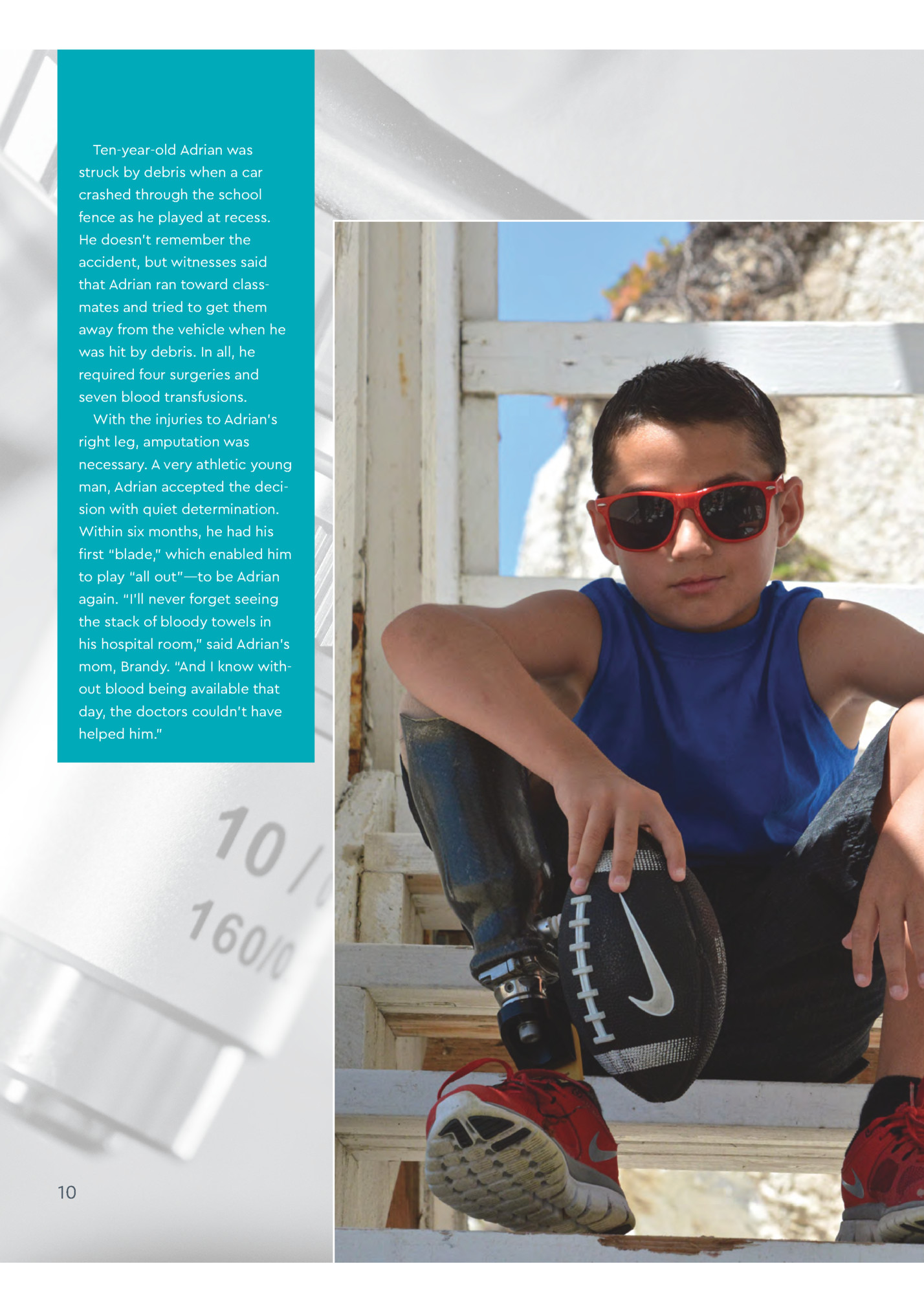
Launch at the historic Hotel Valley Ho in Scottsdale, Arizona. 6

Spokane, WA Sacramento, CA Scottsdale, AZ Denver, CO Lubbock, TX Memphis, TN MAP KEY Blood Centers of the Pacific Lifeblood BloodSource LifeShare Bonfils Blood Center LifeStream (affiliate) Community Blood Services United Blood Services Divisional Headquarters States Served Depots (distribution only) Inland Northwest Blood Center 7

four weeks. These transfusions allow her to regularly attend school—something she was previously unable to do because of immense pain from the disease. As of the end of March 2017, Grace had received 21 transfusions of 168 units of blood. She will continue to require these transfusions until she is able to find a bone marrow donor and receive a successful transplant. Despite everything she faces, Grace is a positive person and passionate about improving the lives of those fighting blood diseases. She actively works to help recruit blood donors and tells her friends, family and classmates about the importance of donating blood and registering to donate bone marrow. 8

THE MODERN BIOCARE business model is built on three sales, coupled with CanyonCARE Rx pharmacy contracts, pillars: consignment, field sales representation and a na- will lead to new business development. tionwide distribution network (incorporating many of the Blood Services locations). Six new factor products were added to the BioCARE portfolio in 2016 and contributed three percent of annual Much of the activity at BioCARE in 2016 involved prepar- revenue. Coagadex® (factor X) sales contributed more than ing operations to become a separate, for-profit subsidiary half of that new revenue. BioCARE is one of only two dis- of Blood Systems effective January 1, 2017. Blood Systems tributors selected to carry the Coagadex product. Similarly, is the sole shareholder of the now-named BioCARE, Inc. BioCARE was named as the exclusive distributor for CEPRO- This large transition did not slow the steady revenue and TIN, which is indicated for patients with severe congenital contract growth BioCARE has experienced since its estab- Protein C deficiency. BioCARE will begin to distribute this lishment in 1980. BioCARE now maintains a separate gov- product in 2017. ernance structure, but will remain part of Blood Systems’ consolidated financial statement. The only change BioCARE President Linda Matthews foresees in day-to-day activity under the new structure is further opportunity for growth and expansion. With Blood Other notable accomplishments include the addition of distribution centers to BioCARE’s network, including locations in Montvale, New Jersey and Memphis, Tennessee. 2016 HIGHLIGHTS Systems’ foresight and support, BioCARE revenues have grown from $17 million in 2001 to nearly $400 million in • 2016 revenue increased 25.3 percent over 2015 2016, which is just over a 25 percent increase from 2015 • Net margin for the year, while slim, more than doubled revenues. Through careful cost management and stringent contracting, BioCARE’s net margin increased over 140 percent from 2015. Several large specialty pharmacy contracts contributed to the significant growth in the non-acute segment, which saw an increase of 64 percent in revenue over 2015. This trend is expected to continue in 2017. Growth in non-acute from 2015 • Non-acute segment revenues rose from $121,852,000 in 2015 to $188,585,000 in 2016 • Six new factor products contributed $11,783,000 in annual revenue; nearly half of that amount ($5,615,000) came from Coagadex® “ Grace requires eight units of blood exchanged every four weeks. Despite the struggles she has endured, she is incredibly kind, positive and optimistic.” 9
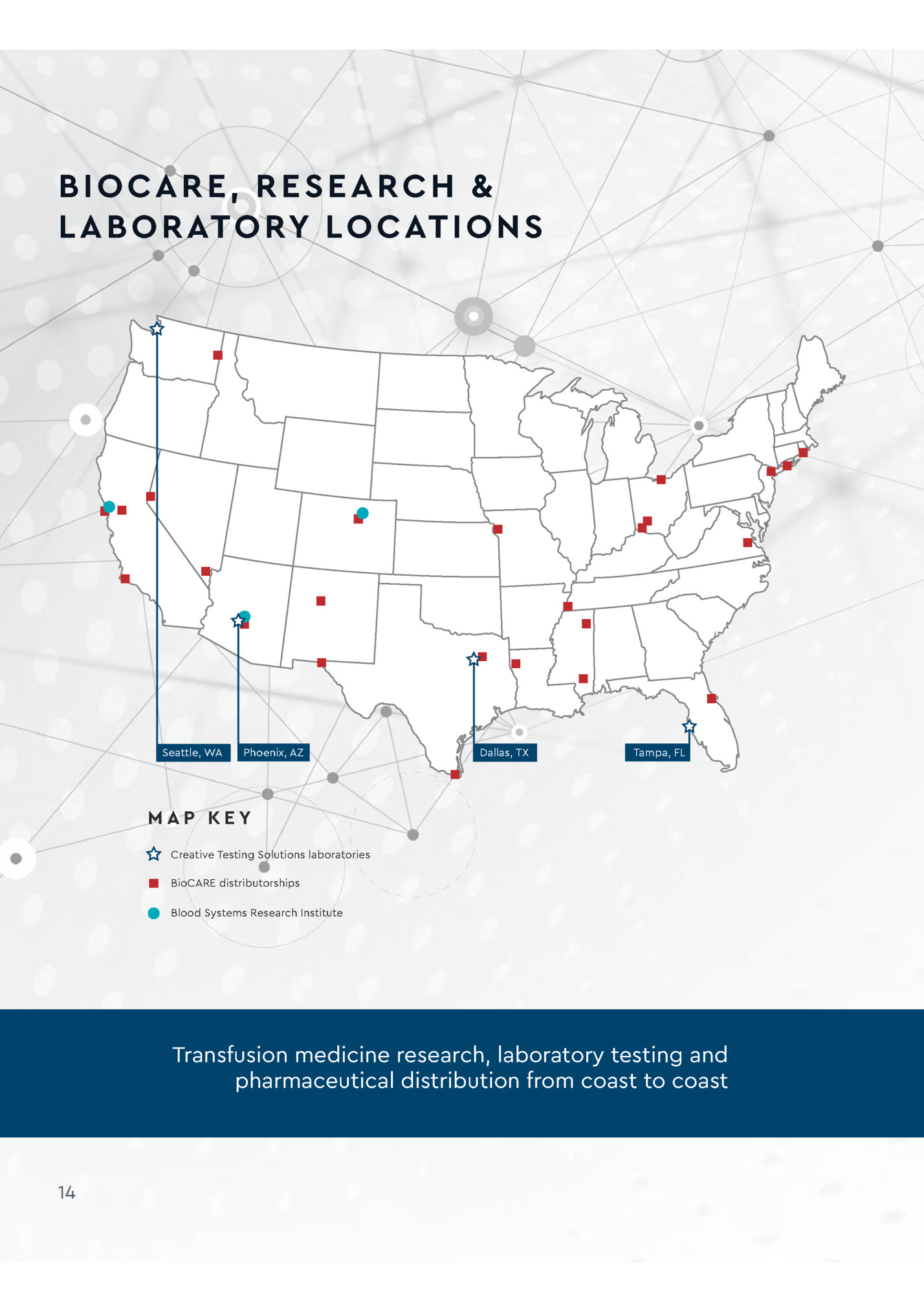
Fleepit Digital © 2021